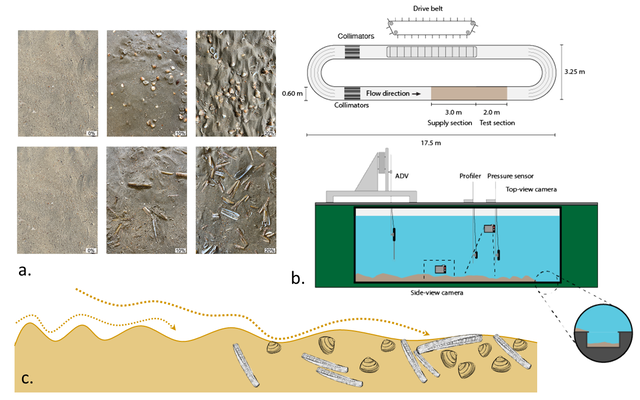T.J. Kooistra1* , S.H. Haarbosch2 , J.W. Bosma3 , S.G. Pearson4, B.C. van Prooijen4, K. Soetaert1, R. Witbaard1,3, T.J. Bouma1,3
1Department of Estuarine and Delta Systems, Royal Netherlands Institute for Sea Research; 2Van Oord, Rotterdam, The Netherlands; 3Faculty of Geosciences, Utrecht University; 4Faculty of Civil Engineering & Geosciences, Delft University of Technology
* Corresponding author: tjitske.kooistra@nioz.nl
Introduction
The seabed rarely consists of bare sand: often other materials, such as shells are present. They can influence sand transport by armouring the bed and increasing its roughness, resulting in reduced ripple size and migration rate. Biogenic shells come in different shapes and sizes: some are round, while others are elongated. Even though they can persist in the sediment long after the animals that produced them have died, changes in species composition can alter the dominant shell types in surface sediments. For instance, the elongated shells of the invasive American razor clam (Ensis leei) are already the most found shells on Dutch beaches. To understand whether such changes in species composition could affect sediment transport, we need mechanistic understanding of the interactions of shell shape, near-bed flow and sand transport.
Objective and Methods
To test how elongated versus round shells influence current-driven sand transport, we performed experiments in a racetrack flume. We compared sandy beds with 10 or 20% shells of Ensis leei (elongated), Spisula subtruncata (round), or a mix of both types. In two types of experiments with (1) rapidly increasing current velocity and (2) constant current velocity, we determined the threshold of motion and quantified bedload transport of sand, respectively. We explain the effects of transport by looking at how the shells influence turbulent kinetic energy (TKE) and bed roughness. Furthermore, we photographed the bed over time to determine surface roughness and shell coverage.
Results
Compared to a bare sand bed, shells increased the threshold of motion of sand in a water-worked bed. Bedload transport of sand containing 20% shells was lower than in a bed with no shells. At 10% shells, the decrease of bedload transport was less apparent. Although more turbulence was created by elongated compared to round shells, there was no clear difference in effects on threshold of motion or bedload transport between the two types of shells. Eventually, these results help our understanding of the impact of biota on sand transport and in could aid in improving sediment transport predictions.

Schematical overview of the experiment: pictures of sandy beds with 0, 10 or 20% Ensis or Spisula shells (a); flume setup (b) and bed armouring by shells (c).


